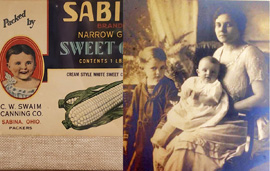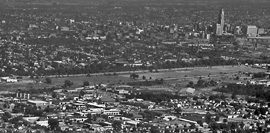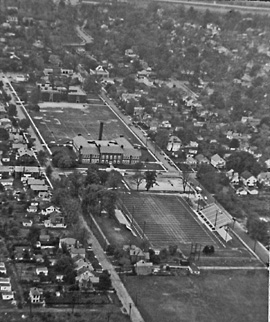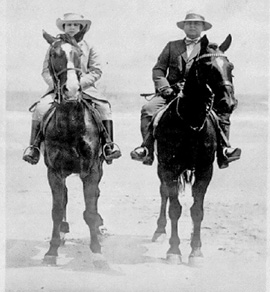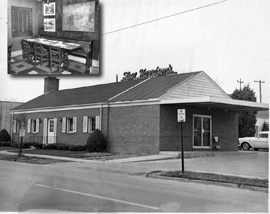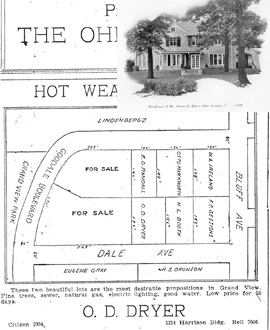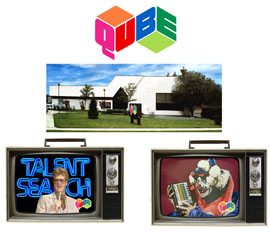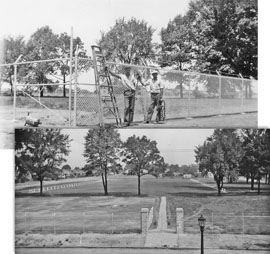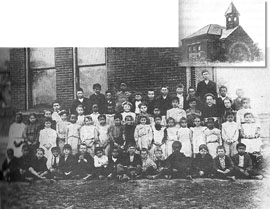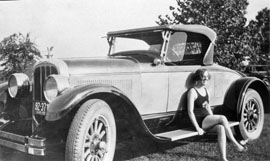An aerial view (looking south) from the early 1950s shows the Grandview Heights Schools complex. At the top is the Edison Intermediate/Larry Larson Middle School building, which was built in 1911 (the west side was added in 1930). This photo does not have either of the south additions, which were completed in 1957 and 1971, nor the multi-purpose addition (added in 1995). The High School was built in 1923, and this photo does not show the gymnasium or the industrial arts additions (also 1957 and 1971). The Stadium was a WPA project that was completed in 1938. This photo shows the tennis courts at the south end of the field on Third Avenue, but no track around the field. Note the houses located on the football field property at the north end of the field, and the commercial auto shop to the east of the Grandview Library at the top-center of the photo.
The home in this photograph is the 1248 Cambridge Blvd. residence of Sanford B. Belden (inset) and his wife Bessie May. Sanford Belden was the Vice President and general sales manager of the Jeffery Mining Company in Columbus. The house photo is from a circa 1916 brochure published by the King Thompson Company, "The Country Club District," created to showcase the new development called Upper Arlington. Mr. Belden graduated in 1895 from Engineering at Ohio State. He was born in 1872 and was a classmate of Orville Wright in high school in Dayton. Jeffrey Mining was the largest manufacturer of heavy coal mining equipment and electric locomotives in the world. Mr. Belden was very important in the business world and was touted as one of the highest salaried industrial executives of his day. He and Bessie travelled the world and their comings and goings were often reported in the New York Times Society pages.
Excerpts from the GHMCHS publication Sheltering a Heritage indicate that this house at 1226 Broadview was built for Elizabeth Ohnsman in 1892. Her husband John (a local farmer), died a year earlier, leaving Elizabeth and her six children to fend for themselves. Records indicate that the house was the only house on Broadview for nearly a decade before others were built south of First. The date of the photo this is unknown but it shows an addition that was reportedly added to the back of the original structure. Elizabeth's youngest child John Levi built his home and office just to the south on the northeast corner of West First and Broadview, now the site of National City Bank. John was a prominent cement contractor. The 1930 edition of History of Franklin County states that practically all the sidewalks in Grandview and Upper Arlington were laid by his firm.
Sororities and fraternities were a part of the social network for Grandview High School students from 1915 until they were disallowed in Ohio by an action of the state legislature in 1960. Although they were never sanctioned by the school, they provided a structure for service, activities, events, and meetings for students. The oldest boy's organization was the Brotherhood of the Rook, established in 1915, joined later by the Adonis Club in 1953. The girls had two sororities, the L.A.L. sorority, started in 1922, and the Delta Gamma Pi, which started in 1929. This 1932 photo shows girls from DGP on a "rush" party for new members, which was a 7:30 a.m. bike ride up and down Riverside Drive. Shown are Kay Field, Betty Booth, Alice Beaman, Jane Harmount, Ruth Shoemaker, and Dolly Brock.
Marble Cliff residents William J. and Ada Boyle Merkle had three sons and three daughters. Mr. Merkle and his daughter Jessie are shown riding their horses together in Florida. From 1910 to 1922 the Merkles lived in the home originally built by Silvio Casparis at 1539 Roxbury. It was later the convent on the property of Our Lady of Victory Catholic church. Mr. Merkle inherited the family business, which operated retail stores in many railroad terminals throughout the midwest. The Merkles often vacationed in Palm Beach, and had their Packard automobile and their horses shipped by rail so that they had them there. Mrs. Merkle was originally from Cincinnati and was the daughter of the secretary to Ohio Governor and U.S. President William McKinley.
In 1932, the northeast corner of Grandview Avenue at Fifth Avenue was a miniature golf course, built with cinder fairways. Stew Harrison was a 34 year old with an appetite, as he indicated in a 1981 interview. "I figured that since I got hungry in the middle of the night, so did others," he said. So the entrepreneur bought the golf course and erected a 12'x12' building on the property, which he called the Hamburger Construction Company. With his two-burner hot plate, he began making 4" hamburgers which he sold for 10 cents. He was eventually more successful than his first-day take of 67 cents, and over the next 24 years he expanded the small building 4 times and renamed the business Stew Harrison's Restaurant. In 1956 he tore down all but 3 rooms and created a dining room (shown here), and by 1981 had 25 employees serving over 400 meals a day. The restaurant finally closed in 1984. The site has since been the location of a series of restaurants, including Sister's Chicken and Biscuits (started in 1979 by Wendy's), Spaghetti Shoppe, Hoggy's and the Winking Lizard. Cleveland-based build-your-own-taco joint Barrio will soon be taking over the Winking Lizard space. The inset photo shows graffiti-carved planks from the early days of Stew's. The planks contain initials, college names, devotions to sweethearts, and other messages. The Historical Society now has several of these planks in their archive.
Mr. Orson D. Dryer was offering two lots (that were adjacent to his home on the Wyandotte Rd. hill) for sale in this ad in the Sunday, July 3, 1910 Columbus Dispatch. The advertisement does not mention any affiliation with a real estate company so one can assume that Mr. Dryer was one of many land speculators that resided and had invested in the area. The plat shows the location of his residence at 1083 Wyandotte, shown in the inset (taken from the Country Club District brochure produced by King and Ben Thompson, which can be found on the Historical Society website.) Lots at the time were priced at approximately $500 per acre (equivalent to $13,500 in 2020, an increase of about 2600%). Note that Wyandotte Road, south of Bluff, was named "Dale Ave" in 1910. Lincoln Road was named "Paul Avenue", and Elmwood, south of Bluff, was known as "Elmer". None of the above named streets were paved at the time. Mr. Dryer was the owner of O.D. Dryer & Co., a Columbus interior decorating and curtain and wallpaper supplier. Mrs. Dryer was very active in Columbus cultural and political affairs, serving as Chair of the Franklin County League of Women Voters, Daughters of the American Revolution, the Columbus Art League, and the YWCA.
In the late 1800s, the local community experienced an influx of Italian immigrants. Many came to the area to work in the quarries located west of the village called Arlington, later to be known as Marble Cliff. Families settled in the San Margarita community, and in the northwest side of what would become Grandview Heights. The original Italian community in Grandview dates to around 1900 and was located on Westwood and Glenn Avenues between Third and Fifth. This map was published 25 years ago in the GHMCHS publication, The Italian Heritage, and lists the resident families and the locations of their homes in the community around 1910-1915. At the time, a large pond was located to the west of Glenn Avenue. Assimilation of many of these immigrant families was neither immediate nor easy. Letters in the GHMCHS archives refer to the building of an eight to ten foot high fence, painted dark green, that was erected between Wyandotte and Glenn Avenues. It traversed the entire block and was ostensibly built to confine the Italian community's chickens, goats, and other farm animals. It was constructed around 1910 when Wyandotte Avenue was being developed. It is not known when it was removed.
This building at 1381 W. Third Ave. was built and purchased in 1925, and has always been a business that cares for cars and their owners. Previously owned and operated as an auto repair business , never as a gasoline station, it was purchased in 1969 by George W. Burchfield (inset). His sons Ted and Larry worked for their father throughout their high school and college years. After serving in the Army, Larry came back to the garage to help his father and eventually took over the everyday operation in 1982. The business flourished as the Burchfield reputation grew. Repairing cars and dealing with customer's concerns about their vehicles became second nature with the business. This led to Larry offering advice to and purchasing cars for his customers.
This photograph, taken in 1984 by a Columbus Citizen Journal photographer, shows the construction of what would be the home of the Columbus Mineshaft Restaurant, on the bluff overlooking the quarry on the south side of West Fifth Avenue. The Mineshaft was owned by Carlos Garcia, who also had interest in the 94th Aerosquadron and the Confluence Restaurant. The restaurant was renamed the Miner's Den, and later became one of several Baby Doe's Matchless Mine restaurants across the country. They used a mining theme, which included an "entrance made to look like a mineshaft, flanked by various mining-related artifacts such as tipple cars on narrow gauge rails and rusting hoist machinery." The dining room had large windows that provided an excellent view of the quarry lake below. The Daimler Group razed the building in the mid 1990s.
A former appliance store on Olentangy River Road at Third Avenue near Grandview became the new home of Warner Communication's QUBE interactive television effort in 1977. QUBE was a revolutionary approach to television, marrying cable and computer technology to give viewers the opportunity to interact with their TV. Viewers used a set-top box and remote with "five interactive buttons which were used to play games, shop at home, and answer questions" to send responses to the cable service. QUBE was the home of several groundbreaking shows, including Flippo the Clown's Magic Circus, America goes Bananaz, Soap Scoop, and Talent Search. Programming included what is now called Pay-Per-View, interactive games, children's shows, and local shows such as Columbus Alive. QUBE went out of business in 1985, and was replaced in the building by Lyon Video. The facility and an adjacent former bank were recently razed to make room for commercial developments, including Miller's Ale House. Photos and more extensive information on QUBE can be found online at http://www.qube-tv.com/qube-tv/index.html )
A common practice in the late 1800s and early 1900s was to make personal photos into postcards, and they have become very common as historical records of the time. In March of 1910 Adrienne Frame Howell of 1100 Broadview Ave. (upper right) sent the picture postcard (left) of her new "living room" to her brother Augustus Frame of Athens, Ohio. Adrienne was obviously a devotee of the Arts and Crafts style of the period. She used the new term "living room" in her message on the postcard, and she sparsely furnished the room with mission style, craftsman oak furniture like the library table and rocker in the foreground. Her dining room (lower right) included simple oak furniture, an authentic Tiffany hanging lamp, and built-in cabinets typical of the period and style. An avid china painter, Adrienne maintained a studio on the second floor of her home for that creative purpose.
Gus Amicon (above in white apron) stands outside of the Amicon Market in 1938 waiting to be interviewed by a local radio station for a Taystee Bread promotion. Gus and his brother Rocco Amicon immigrated to the United States in the early 1920s, and built the store at the corner of Fairview and Fifth Avenue in 1930. The building is currently occupied by the One More Time clothing store. Starting with an inventory of only vegetables and fruits, they added refrigeration and over the next few years became known throughout the city as having some of the best meats in town. A chicken coop behind the store provided fresh birds, and steaks and bacon were cut fresh daily. In 1931 Rocco and his family moved into one of the two apartments on the second floor, and Gus lived in the other. In 1940 Gus opened his own store at First and Oxley, and in 1946 Rocco opened a popular restaurant in an addition next door. The restaurant closed in 1956, the store in 1958, and Gus retired from his store in 1969.
Started during the Great Depression, the federal WPA (Works Progress Administration) provided funds for construction, renovation and other projects across the country until the postwar boom in 1943. In Grandview the WPA was responsible for constructing, renovating and maintaining city school district buildings and grounds. The program earmarked $28,000 for the construction of a new stadium on the athletic field north of the GHHS on the condition that the district could contribute $3,000 towards the construction effort. The top photo shows WPA workers doing site preparation by erecting a barbed wire chain link fence. They are standing at the northwest corner of Fairview and Third Avenues. The bottom photo shows the athletic field just prior to construction of the stadium. The 1250 seat stadium was completed and dedicated on October 7, 1938. The construction was not without considerable political drama and controversy, including additional demands from the federal government. Visit the "History of the Grandview Schools" link at the GHMCHS web site at www.ghmchs.org for additional details.
This circa 1900 photograph shows students from what was at the time called the "Polkadot School" standing outside their one room schoolhouse. The school (inset) was located on the west side of Virginia Avenue near Chambers Road and got its name from the fact that it was equally integrated. It served the residents of Sellsville, an unincorporated community bordered by the King and Fifth Avenues (north and south) and the Olentangy River and Virginia Avenue (east and west). It was a vibrant, racially mixed community comprised of blacksmith shops, saloons, truck farms, slaughterhouses, and most notably the winter home of the Sells Brothers' Circus. These photographs are from the 1971 book, Sellsville Circa 1900, written by Carl Weisheimer. It is a rich, detailed compilation of the early history of the community. The names of all the students in the photograph are listed in the book.
John Jonas Chester was a prominent Columbus attorney. Born in Newark Ohio in 1860, he was also an enthusiastic outdoorsman and real estate developer. In 1892 he purchased over three hundred lots in what would become in 1906 Grandview Heights. His development was called "Chester Heights", and its boundaries were present-day Elmwood Avenue to the east, Lincoln Avenue to the west, First Avenue to the north, and Goodale Boulevard to the south. In 1892 he also became a charter member of the "Bit and Bridal" riding club, whose members used the Urlin farmhouse, where Summit Chase is located today, as their club house. It was the first country club in central Ohio. John's son John Jr. also was an attorney and gained notoriety as the prosecuting attorney during the 1929 murder trial of Dr. James H. Snook, a prominent O.S.U. professor who was executed for murdering his mistress, an O.S.U. medical student.
Caroline Thomas Harnsberger, born in 1902, lived with her family on her great grandfather's 358 acre farm covering most of the east side of what is now Grandview Heights. Their home was located on the hill above Goodale and Northwest Boulevards. Caroline was one of six children born to James O. Thomas and Edith Margaret Hiss Thomas. Caroline, pictured here sitting on the running board of her 1920's car, was an active swimmer in the "old swimming hole" located near Dublin Road and Grandview Avenue. She won several diving competitions held there. Caroline went on to garner many more accomplishments in her lifetime. She was educated at The Juilliard School of Music and became a professional musician playing violin for the Chicago Women's Symphony and later with the Evanston Symphony, which she also helped establish. She was married at 23 in 1925, and as wife and mother she became a prolific author, publishing nine books on Mark Twain. She was one of the world's foremost Twain scholars. Among her published books was "A Pilot's Ready Reference Manual" . She obtained her pilot's license at the age of 50 in order to fly as co-pilot with her husband, Audley Harnsberger, and her two sons. That book sold more than 30,000 copies with 12 editions. Caroline returned to Grandview Heights after her husband's death and took up painting. She died in 1991 at the age of 89.
The parcel of land for this church was legally recorded as the West Fifth Avenue Methodist Episcopal Church, which at the time was located at the north west corner of West Fifth Avenue and North Star Road in April, 1891. This new land was provided by The Reverend James S. Ricketts. At the time the church was originally formed it met in private homes, until the Methodist Conference appointed the Reverend William C. Holliday as the first official minister. The membership grew and a chapel was built on the corner of West Fifth and North Star in 1902. The population of the area and the membership grew and this new church building was erected in Grandview Heights near the corner of West First and Ashland Avenue. The name was changed to Trinity Methodist Episcopal Church. The time at this location covered World War l and the depression years and a name change to Grandview Methodist Episcopal Church. This congregation continued to grow under the leadership of Frederick Ross, who was appointed in 1922. 1939 brought Paul Rugg to the steadily growing congregation and in that year the decision was made to buy two lots at the corner of Cambridge and West Fifth. In the next ten years the lots were paid for and construction was started on the now Trinity Methodist Church, renamed once more. The first service in the new building was held September 30, 1951. Today's congregation enjoys new additions to the building and updates to offices and a still growing attendance to the church that started with 64 neighbors and is still named Trinity Methodist Church.


